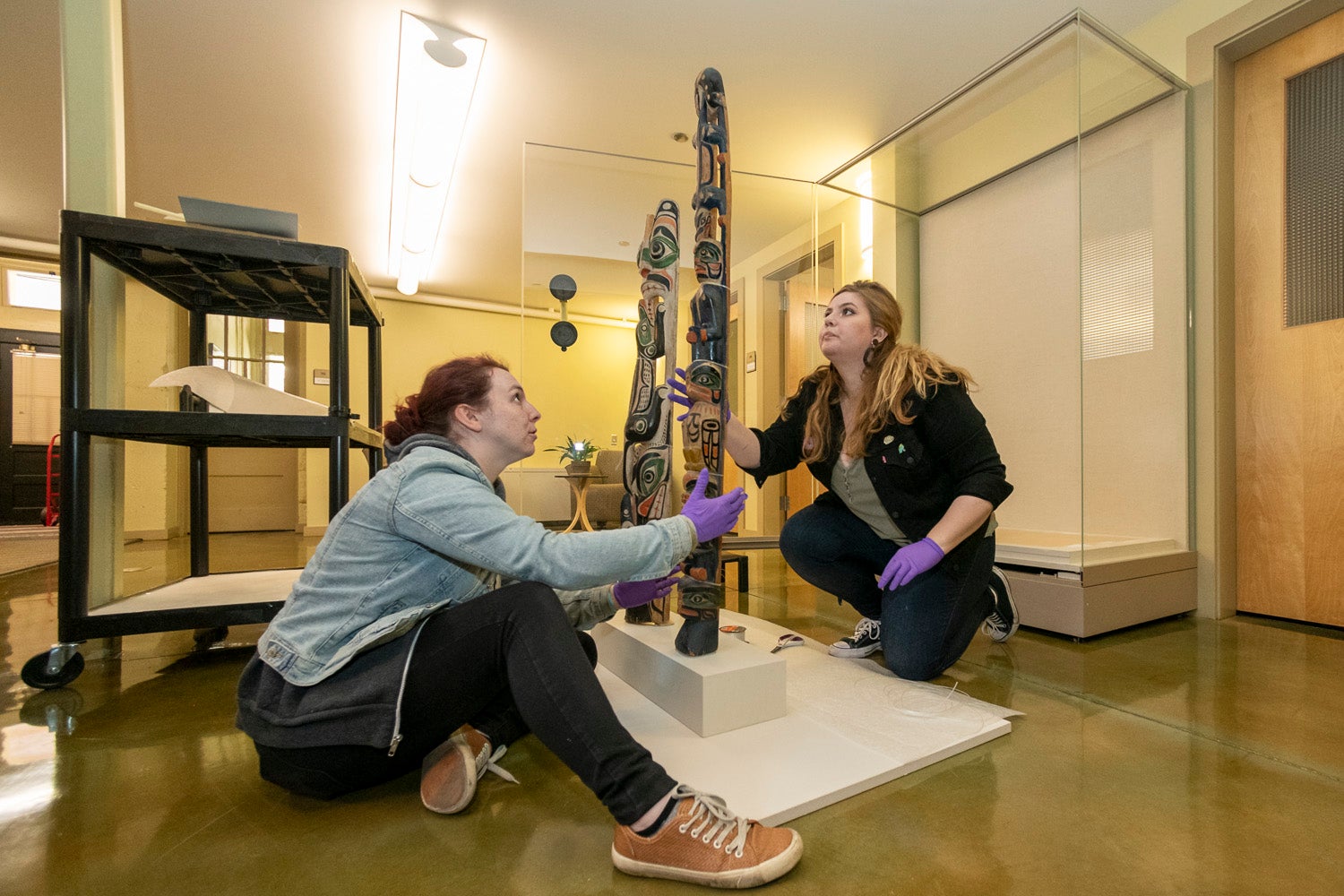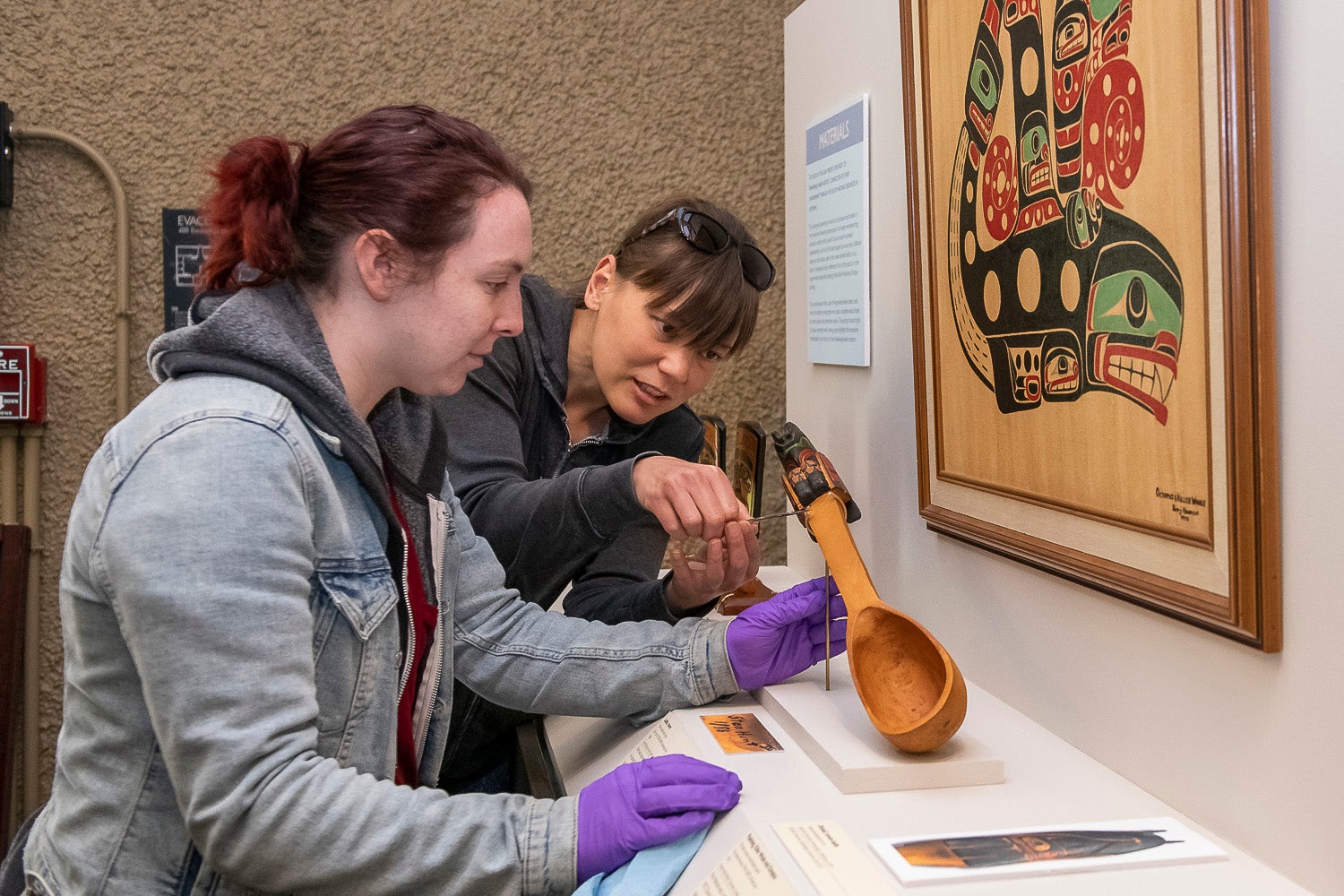New Stanford exhibition showcases Northwest Coast indigenous art
Totem poles, silkscreen prints and other objects created by Northwest Coast indigenous artists donated to Stanford and gathered by Jane Stanford and Stanford alumni are on display as part of a new exhibition at the Stanford Archaeology Center.
Colorful model totem poles, a wooden ladle with a carved raven handle and a silkscreen print of swimming killer whales are among several objects created by Northwest Coast indigenous artists and curated by a class of Stanford students that are now on display at the Stanford Archaeology Center.

Stanford Archaeology Collections technician Sara Godin and collections assistant Veronica Jacobs-Edmondson secure historic model totem poles now on display at the Stanford Archeology Center. (Image credit: L.A. Cicero)
The exhibition, called Trading Faces: Aspects of a 20th-Century Northwest Coast Collection, showcases items crafted primarily by artists of Kwakwaka’wakw tribes in Canada, but also includes work by indigenous artists from tribes in Alaska, Canada and the Northwest U.S. The name of the exhibition references the many faces of spirits, animals and humans that are key to Northwest Coast design and meanings, which can be seen across the collection.
Most of the objects hail from the late 20th century and were bought at the Campbell River Museum store on Vancouver Island, British Columbia, by a collector who donated them to Stanford in 1998. Older items came from Jane Stanford’s collection or were donated by Stanford alumni.
“The contemporary art is from a period of an expansion of the Northwest Coast art and its recognition worldwide that started in the 1960s,” said Christina Hodge, academic curator and collections manager of the Stanford University Archaeology Collections. “The work is rich in its cultural expression and shows an integration of complicated iconography and sophisticated modern styles.”
A group of undergraduate and graduate students installed and curated the materials as part of the spring course Museum Cultures: Material Representation in the Past and Present, instructed by Hodge.
The course, which has been offered every spring quarter for the past several years, offers students a unique opportunity to work directly with artifacts and other materials in Stanford’s collections.
Sophomore Blake Sharp said her favorite part of the class has been learning about the mythology and culture of Native American tribes in Northwest America. She said she was particularly captivated by the tradition of potlatch – a ceremony to celebrate a significant life event. The family usually throws a days-long feast and invites other families in its tribe, giving them gifts and food.
“It’s an incredibly interesting way to think about wealth and status within a society,” Sharp said.

Stanford Archaeology Collections technicians Sara Godin and Suzy Huizinga make final adjustments to the mount for a hand-carved wooden ladle. (Image credit: L.A. Cicero)
As part of the exhibition, Sharp examined and mounted a silkscreen print depicting two Bakwas, which are supernatural spirits in the legends of Kwakwaka’wakw people.
Sharp also examined the structure of pigments used to paint a 3-foot model totem pole in the exhibition. Sharp had learned about X-ray techniques for examining pigments while working at the Cantor Arts Center, so she wanted to use what she’d learned during Hodge’s class to find out more about how the totem was created.
That particular totem captured Sharp’s interest – and the interest of Hodge and other researchers – because it was stylistically distinct. It portrays carved figures of a raven, a wolf and killer whales, which are traditional symbols, but is painted with a larger variety of colors than the traditional full-size totem poles, which usually include black, red and sometimes white and bluish-green colors.
Sharp found that the artist used non-traditional pigments for some colors. For example, the green on the totem did not contain copper and the white pigments didn’t have lead, both of which were present in the traditional colors used on full-sized totem poles.
Totem poles share stories and figures that serve as a family’s or clan’s emblems. Each totem includes distinctive symbols, animals and artistic styles associated with that group.
“It’s a complicated and fascinating system,” Hodge said. “It’s interesting to see how traditional rules influence what individual artists choose to make, even when they’re experimenting with Western art.”
Sharp, who is majoring in computer science, said she took Hodge’s class because she was interested in learning about the technical side of conservation and museum exhibitions. Growing up, Sharp has gravitated toward museums because she likes learning new facts.
“On the school field trips, I was the person who would always spend like three times longer at exhibits, so no one would want to go with me,” Sharp said. “I love how you can learn about different things and cultures by going to museums.”
The new exhibition represents an ongoing interdisciplinary collaboration between the Archaeology Center, Stanford University Archaeology Collections, the Cantor Arts Center and the Native American Cultural Center.
The public is encouraged to visit the exhibition, which will run through May 2020.
